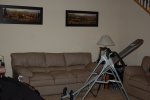Clearly you haven't tried sitting in front of one of these monitors. You have to move them further away simply due to their sheer width. At a comfortable viewing distances the PPI is fine and is not visually objectionable.
That's fine if you either have 20/20 vision, or don't mind corrective lenses, plus you have the desk space to move your monitor back. None of those apply to me.
Also, if the monitor is far enough away so you don't see the pixelation, that means it's not filling up your field of view. Take vertical height, for example. At my viewing distance of about 12 to 14 inches, the 12 inch vertical height of my monitor just about fills my vertical field of view. I'm estimating if I had a curved monitor it could be roughly 24 inches wide and it would fill my horizontal field of view. In terms of diagonal measurement that would be about a 27" 2:1 aspect ratio monitor. Anything wider will give me unusable horizontal real estate unless I move it further away. However, if I do that then I lose potential vertical real estate. Let's use the 49" Dell as an example. It's about 47" wide, so it needs to be viewed at roughly twice my normal viewing distance to take full advantage of it's width. However, the ~13.33" vertical height at that distance is now equivalent to a vertical height of only half that, or well under 7", at my normal viewing distance. Sure, a 7" high monitor at my normal viewing distance with 1440 vertical pixels won't have noticeable pixelation, but there would also be a lot of potential lost vertical real estate. This is a convoluted way of saying these ultra-wide monitors really don't match our visual fields.
To fill our visual fields and not have noticeable pixelation, you probably can't go much over 2:1 if the monitor is curved. In either case, you need about 4000 vertical pixels. The physical size doesn't matter here. That will depend upon your intended viewing distance. For me a ~27" 8000 x 4000 monitor would work. If you're comfortable viewing from 24" then maybe something like a ~50" size of the same resolution would work. The only way lower resolutions work is if you're either fine viewing the monitor from such a distance that it doesn't fill your entire field of view, or just accepting pixelation. It's normal to view TVs at distances where they don't fill your visual field so you don't notice the pixelation. However, I don't find working on a computer that way to be comfortable. If I can see anything but just the monitor then I'm either sitting too far away, or the monitor is too small or too wide.
Here is a good description of all this. This source gives the aspect ratio of human vision at around 1.87:1. That's the widest any flat monitor should be. 2:1 or so works if you have a slight curvature.



